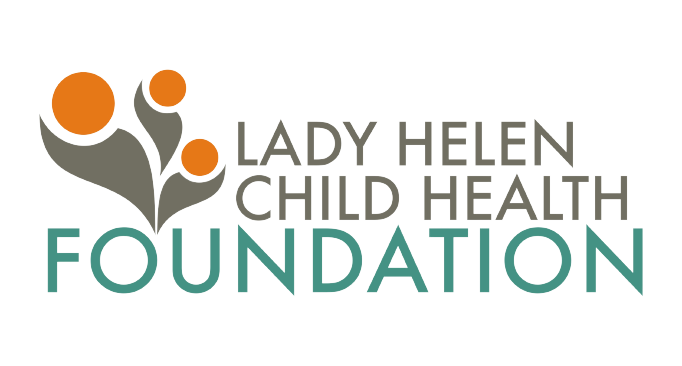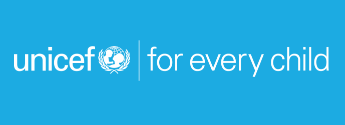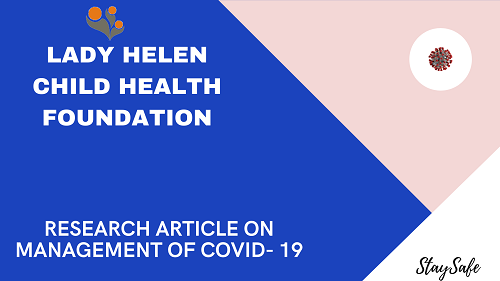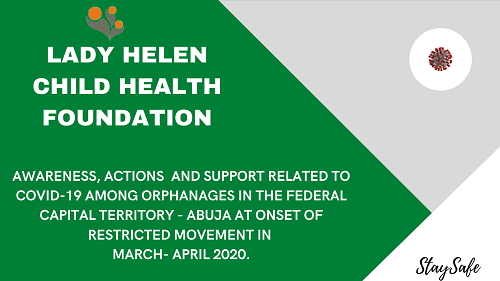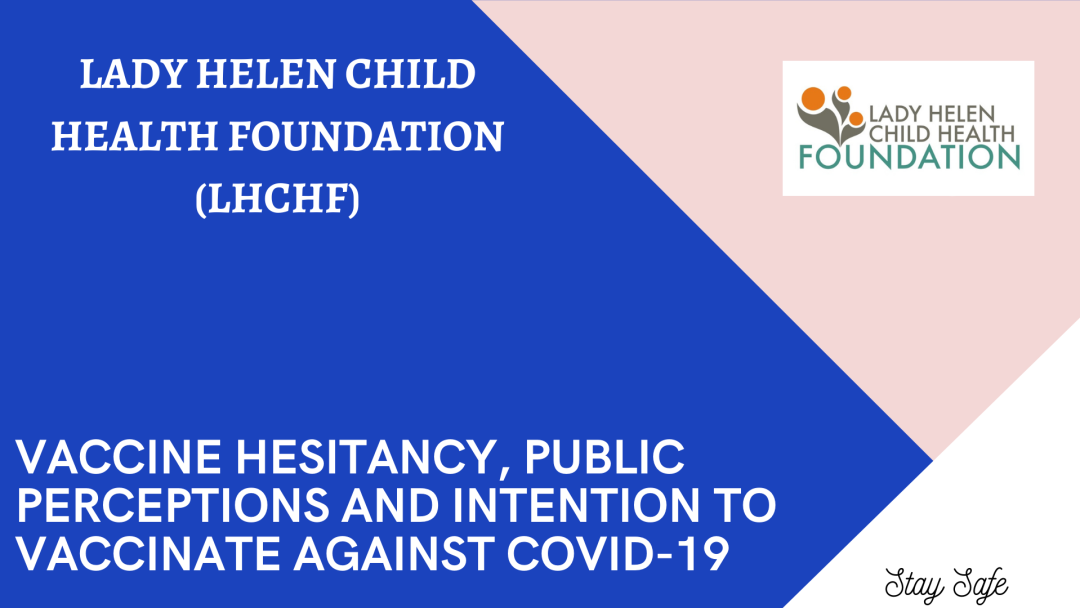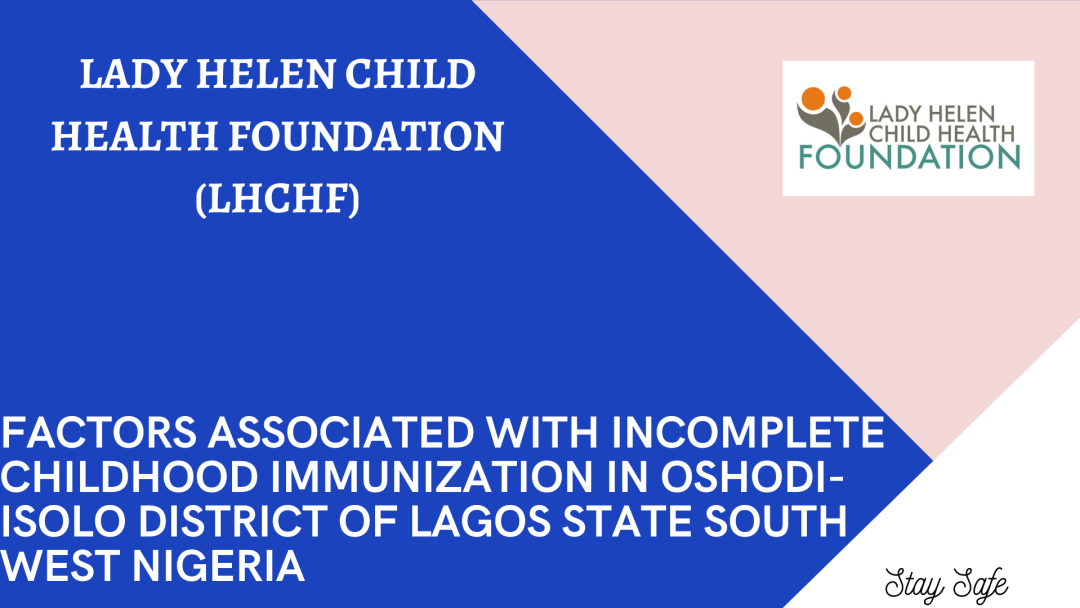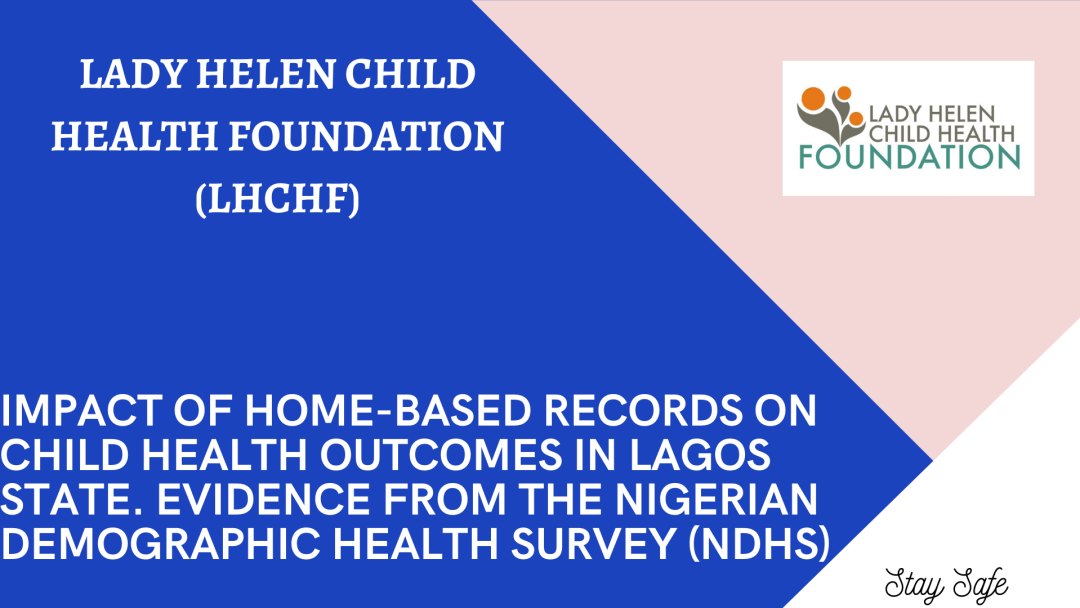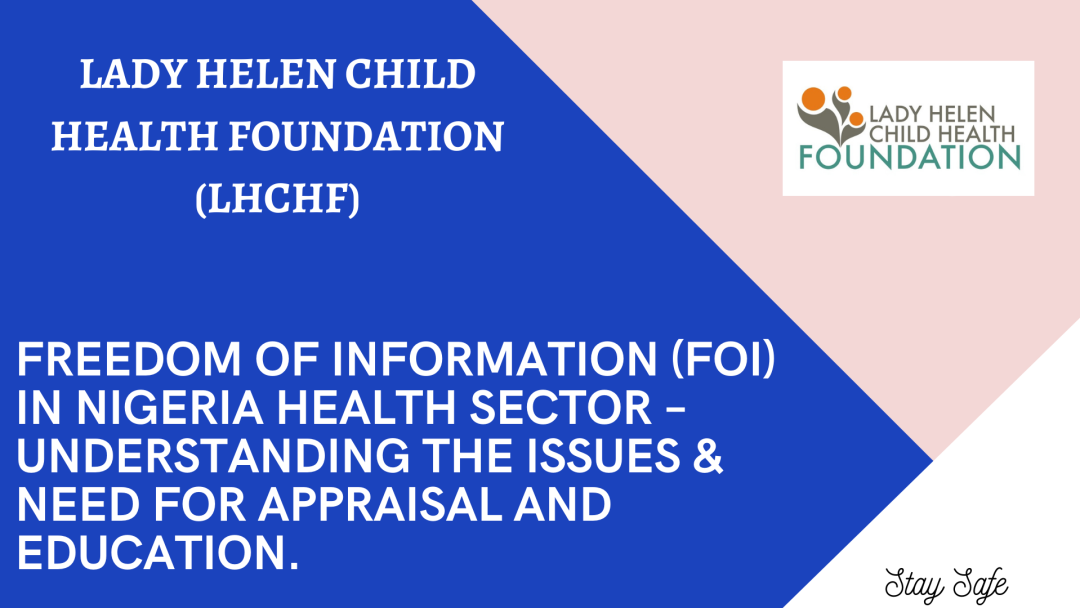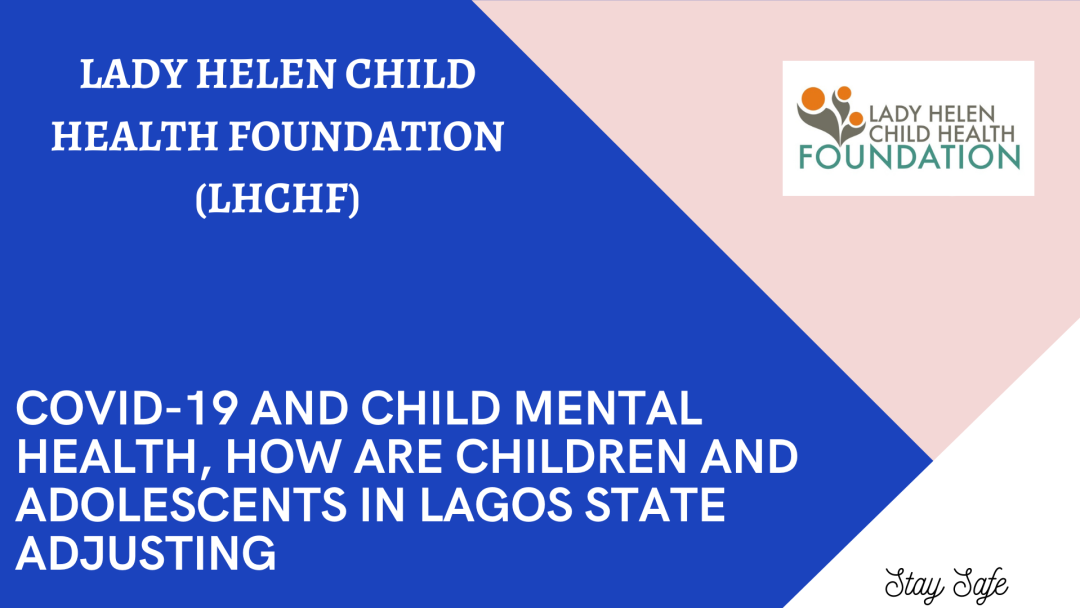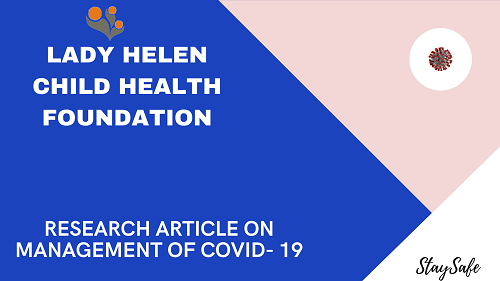By
Aliyu Yusuf BSc Anatomy. Research Fellow Lady Helen Child Health Foundation
Dr Benjamin Odeka MB BS DCH MA FRCP FRCPCH – Director of Research LHCHF
Awareness ,Actions , and Support Related to COVID-19 Among Orphanages in the Federal Territory of Abuja at onset of Restricted Movement in March- April 2020.
Background:
Nigeria is among the top three countries in the world with the most orphans. Many of these children have no other option than to live in orphanages. However, are orphanage homes in Nigeria able to provide proper care for the kids? What issues do Nigerian orphanages face? The purpose of this desk review is to assess the challenges affecting orphans and vulnerable children (OVCS) and their caregivers in Nigeria.
Methods:
LHCF research team conducted a desk review of available published reports and other project and program documents — including peer-reviewed and gray literature — related to nutrition, OVC, and caregivers, with emphasis on OVC interventions globally and in Nigeria. Materials included formative research and other studies, previous assessments, project reports, and surveys.
Introduction:
Nigeria’s Federal Ministry of Women Affairs and Social Development estimate that there are 17.5 million orphans and vulnerable children (OVC) nationwide. These children face enormous challenges to their health and development and it is estimated that 95 percent of OVC do not receive any type of medical, emotional, social, material, or school-related assistance (National Population Commission, Federal Republic of Nigeria, and ICF International 2013). Childhood malnutrition is one of the major causes of childhood morbidity and mortality in Nigeria and a cross-sectional study of 2015 revealed that more than a quarter of OVC studied showed symptoms of mild to moderate malnutrition. In addition, close to 70 percent experienced household food insecurity, putting them at risk for malnutrition (Tagurum et al. 2015). Nigeria is currently expanding its support to OVC as well as their caregivers, households, and communities through the rollout of the 2014 National Standards for Improving the Quality of Life of Vulnerable Children. A significant programming challenge is ensuring that OVC have access to a diverse and nutritious diet. As caregivers become ill or die, household labor supply is diminished, which dramatically affects income and/or the ability to cultivate land. Access to nutritious foods dwindles and families often resort to harmful coping strategies to survive. Complicating this scenario, those individuals living with HIV have higher energy requirements.
Definitions:
Defining the term OVC is the first step in understanding the magnitude of the OVC problem and the responses offered by various United Nations and donor agencies, including USAID, nongovernmental organizations (NGOs) and governmental ministries. It is also a critical step in determining the types of nutrition SBCC programming that may have the greatest impact for OVC populations in Nigeria.
In 2004, the World Bank established an OVC Thematic Group to respond to the worldwide OVC crisis due to HIV and AIDS, and developed an OVC toolkit for sub-Saharan Africa (SSA) (World Bank Africa Region and World Bank Institute 2005).
The World Bank defines OVC as children who are-
- orphaned
- separated from their parents
- living with caretakers with serious problems like illness, disabilities, trauma, substance addictions, abusive habits, or
- Having normal families, but special needs that even well-functioning parents will need help to address (trauma, disability, behavioral problems).
The World Bank further defines OVC as children who, in a given local setting, are most likely to fall through the cracks of regular programs, policies, and traditional safety nets and therefore need to be given special attention when programs and policies are designed and implemented. UNAIDS defines OVC much more narrowly, focusing only on orphans and defining them as children under 18 years of age whose mother, father, or both parents have died as a result of AIDS (United Nations, 2004).
A global perspective on the magnitude of the OVC problem:
The estimated number of orphans, by all causes including AIDS, is reported yearly by agencies such as UNICEF. The varied way in which vulnerability is defined and measured across countries, however, makes the precise count of the world’s total number of vulnerable children challenging. Approximations related to specific types of vulnerability attest to the magnitude of the global problem: 428 million children age 0–17 years live in extreme poverty, 150 million girls have experienced sexual abuse, 2 million children live in institutional care, and 218 million children engage in various forms of exploitative labor (Zosa-Feranil et al. 2010).
The most recent UNICEF estimates for the number of orphans (age 0–17 years) globally (referring to loss of one or both parents to all causes) is 140 million, with an estimated 17.7 million orphans attributed to AIDS. In SSA alone there are close to 60 million orphans, a number that represents more than 20 percent of all children in this region. An estimated 15.2 million children in SSA are orphaned due to AIDS (UNICEF 2013); this represents 86 percent of the global burden of orphans due to AIDS.
While HIV prevalence in Nigeria, at 3.2 percent, is lower than that in many other large countries in SSA, (UNAIDS 2014) its large population means the number of adults and children living with HIV is one of the highest in the world, at approximately 3,200,000 (National Agency for the Control of AIDS 2014). Furthermore, the orphan population in Nigeria is estimated to be 20 percent of the total SSA orphan population (AVERT n.d.).
Although official counts vary, the Nigerian Federal Ministry of Women Affairs and Social Development (FMWASD) reported that there were 17.5 million OVC in 2008 (Tagurum et al. 2015). UNICEF reported 10 million Nigerian orphans due to all causes in 2013, with 2.3 million orphans due to AIDS, as well as 450,000 children and 180,000 adolescents actually living with HIV (UNICEF 2013). One study ranks Nigeria’s OVC burden higher than several countries facing war, such as Sudan, Somalia, Democratic Republic of the Congo, Libya, and Syria (Tagurum et al. 2015). One in every 10 households in the country is also estimated to be providing care for an orphan (Marsden and Miller 2011). The 2013 Nigeria Demographic and Health Survey (NDHS) found that the percentage of orphaned children increases rapidly with age, from 4.2 percent among children under age five to 16.1 percent among children age 15-17. Data also indicate that urban children are slightly more likely to be orphaned than rural children (7 and 5 percent respectively). Among UGM project states, Benue had the highest number of OVC (16.4 percent), followed by Plateau (14.1 percent) and Nasarawa (13.8 percent). which adapts the original NDHS data to show the states where UGM project partners STEER and SMILE are implementing programs, provides further explanation of these data.
A cross-sectional survey carried out in the Plateau State in 2014 revealed that paternal orphans made up 59.8 percent of respondents, followed by vulnerable children (21.7 percent) (Tagurum et al. 2015). This is similar to the situation in South Africa, where the majority of orphans have lost fathers (Bennell, Hyde, and Swainson 2002). Paternal orphanhood is significant because of the documented economic difficulties children face when they lose their fathers (Chirwa 2002, Abebe 2005).
Situation with orphans in Nigeria:
It is difficult to say exactly how many orphans and orphanages there are in Nigeria. Despite the fact that this topic is very important, it has been severely neglected by researches. The latest statistics that we were able to find dated back to 2012. According to them, there were over 11.5 million orphans in Nigeria. It is safe to say that the situation has probably worsened since then. Situation with orphanages statistics is even direr, as the government itself does not know for sure how many orphanages operate within the country. It has been said that there are lots of unapproved or illegal orphanages in Lagos and other states. Just from the lack of relevant information and research, it seems pretty obvious that things are not going well for Nigerian orphanages. Nevertheless, let’s talk about the issues with orphanage homes in Nigeria in detail.
Common issues and challenges of orphanages in Nigeria:
Every orphanage home is different. This means that they all have different issues, and some might not have the listed issues at all. However, we have tried our best to compile the most common problems for many Nigerian orphanages.
- First issue we need to talk about is overpopulation. While it is not known how many orphanages Nigeria has, no amount can handle almost a dozen million children that do not have parents and/or homes. This issue is also important to be mentioned first, as many other problems stem from it. For example, many existing orphanage homes are seriously understaffed. People that work with orphaned children are spread thin as they are trying to pay enough attention to all the children. They are overworked, underpaid and exhausted, because working with children is no small feat.
- Lack of staff and unqualified caregivers those employees that do work at orphanages often do not have required qualifications to be working with children. To be fair, some of them should not even be allowed to be close to children, let alone be responsible for their lives and development. Nigeria, as well as many developing countries, suffers from a thing called volunteerism (yes, we are aware that it is a made up word, but it has an important meaning nonetheless). This term describes the practice of people that enjoy ‘giving back’ while they are abroad in less fortunate countries. For instance, they volunteer in orphanages, where they hang out with kids or donate money and clothes. How could volunteering be bad?’ You would be surprised, but it actually brings more harm than good. Many people involved in research of the orphanage systems, as well as those who are directly involved in said systems, reported that volunteerism is harmful for children. People that engage in this type of activity rarely know how to deal with kids. They might be pursuing a noble goal to help the orphans in need, but they might inadvertently cause them harm. In addition to this, volunteers often do not stay long, but children still manage to grow attached to them. When these voluntourists leave the orphanages to go home, this negatively affects the kids’ existing abandonment issues. As for the donations, they, along with the government funds, often disappear in the pockets of those who run the orphanages. Corruption is a prevalent problem that does not help to improve the current situation with orphanages.
- Funding, many orphanage homes in Nigeria do not receive enough money to satisfy even the basic needs of children. Some orphanages in the country, especially those in the rural areas, do not have electricity, plumbing and other necessary facilities. The buildings are often in terrible condition unfit for living. The lack of funds also negatively affects the children’s nutrition and development. This also includes educational programmes. Children do not receive proper education and are often not prepared for the future that lies ahead of them. Kids with special needs suffer from insufficient funding the most, as they might not have the required equipment or educated staff that would meet their needs.
- Unregistered and fake children Home: One of the most horrifying things that exist in Nigeria is fake orphanages. While some exist for the mere purpose of laundering money, some have the nefarious purpose of selling Nigerian children. Nigerian government is struggling to battle this onslaught of illegal orphanages. A few weeks ago, 201 fake orphanages were discovered and closed in Delta State alone. One thought of how many are still left out there.
- The last thing we are going to touch upon is the utter negligence of the people who assign children to orphanages. It has been said that many kids that currently live in orphanages actually have living relatives. They are sentenced to years of living in unacceptable conditions only because nobody bothered to double-check whether they have anyone to care for them or not. Thus, they are deprived of their childhood and the ability to communicate with their families. Overall, staying in an orphanage negatively affects children. Research shows that kids who lived in orphanages have development issues, problems with nutrition, difficulties in adapting to the outside world, as well as many other problems. If the conditions in the orphanages are subpar, the situation only worsens.
Conclusion:
As you can see, there are many issues with orphanage homes in Nigeria. Of course, there are some exemplary institutions that do not fit our profile. Nevertheless, many other orphanages suffer from the same problems. We sincerely hope that the situation will improve in the nearest future, so that children without parents can have a proper chance at life
References
- Abebe, T. 2005. “Geographical dimensions of AIDS orphanhood in sub-Saharan Africa.” Norwegian Journal of Geography,
- AIDSTAR-One. 2011. “Early childhood development for orphans and vulnerable children: Key considerations. Technical Brief.” AIDSTAR-One (now AIDSFree) website.
- AIDSTAR-One. 2012 “The Debilitating Cycle of HIV, Food Insecurity, and Malnutrition Including a Menu of Common Food Security and Nutrition Interventions for orphans and vulnerable children.” AIDSTAR-One (now AIDSFree) website.
- The Federal Republic of Nigeria, and National Bureau of Statistics. “LSMS – Integrated Surveys on Agriculture General Household Survey Panel 2012/2013. A Report by the National Bureau of Statistics in Collaboration with the Federal Ministry of Agriculture and Rural Development and the World Bank.
- National Agency for the Control of AIDS. 2014. “Federal Republic of Nigeria Global AIDS Response Country Progress Report 2014.” UNAIDS website.
- “Nigeria OVC National Plan of Action.” The African Child Policy Forum website(link is external).
- World Health Organization. “Integrated Management of Childhood Illness.) World Health Organization website.
